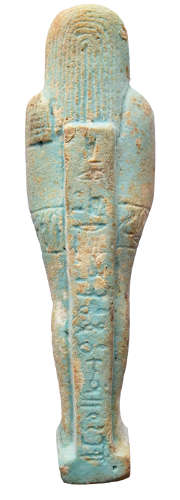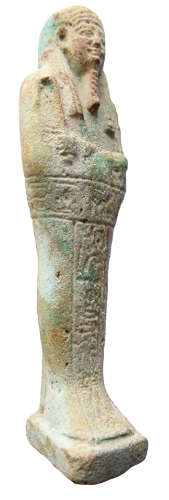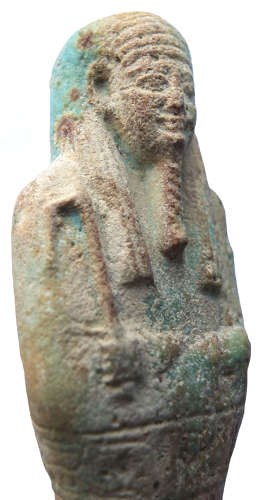Description: A turquoise faience inscribed ushabti, moulded mummiform figure wearing a striated tripartite wig and long plaited beard, arms crossed on chest with hands indicated, holding agricultural tools, and with back pillar. The frontal inscription in the form of a ‘T’ which continues to the back pillar, identifying the owner as Semataui-tefnakht (literally: ‘The unifier of the two lands is his strength’). The frontal column reads Illuminating the Elder priest of Herishef, scribe,…god's seal bearer of Herishef, god's servant of the phyle, scribe… and the back pillar …of Osiris and Isis, lords of northern Abydos, Semataui-tefnakht. The glaze worn with some discolouration particularly on the front, but quite a finely modelled example, probably from Heracleopolis or Abusir el-Melek.
Size: 117 mm/4.6 ins. high
Culture: Egyptian
Date: 30th Dynasty, c. 380-343 B.C.
Provenance: From the collection of Julian Bird (1959-2014) and acquired from Coincraft, Great Russell Street, London, in 2012, and previously in a German private collection.
Background: Julian Bird was a passionate collector of Egyptian antiquities, who built up a fine and extensive collection from the 1970s onwards. He sourced his items mainly from the UK market, from specialist dealers, fairs, markets and auctioneers. He was a model collector, carefully documenting his collection, and his notes on this particular item will be supplied to the buyer.
Notes: Several other shabtis of this individual are known, some which include the name of his mother Nebetkereh. The name Semataui-tefnakht is well attested for the Late Period (cf. Ranke, Personennamen, p. 296 no. 13). Semataui (‘The unifier of the two lands’) was a falcon-headed local god of Heracleopolis Magna who is often identified with Horus. The owner of this shabti, Semataui-tefnakht, bears many priestly titles connected with Heracleopolis Magna (modern-day Ihnasiya el-Medina), the principal town of the 20th Nome, located near the Fayum:
Elder, god's servant, scribe and god's seal bearer of Herishef.
Herishef (‘he who is on his lake’) was the main local god of Heracleopolis. Elders were responsible for the jurisdiction and the administration of the temple, and were chosen from the god's servants to whom Semataui-tefnakht belonged. God's servants were priests at the temple who performed the cult for the god while god's seal-bearers and scribes were responsible for the temple administration. Semataui-tefnakht was also god's servant and scribe for Osiris and Isis in ‘northern Abydos’, the name of the necropolis of Abusir el-Melek to the north of Heracleopolis.






